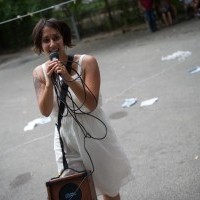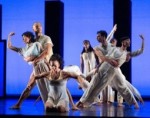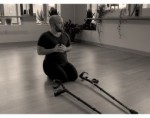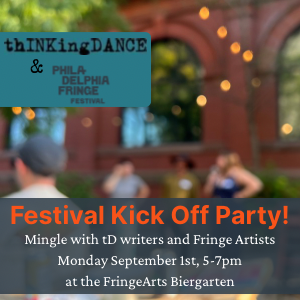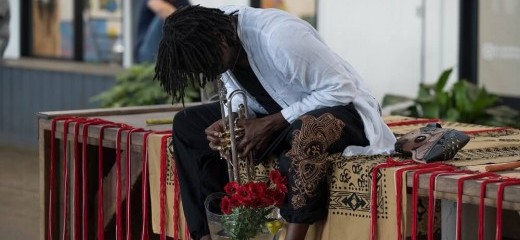
Constructing Memorials in Bodies, Site and Sounds
by Kristen Shahverdian
WE WILL NOT
WE WILL NOT
WE WILL NOT BE CONTROLLED
I AM SOVEREIGN IN MY BODY
I AM SOVEREIGN IN MY SOUL1
This incantation, sung together by artists and audience, began Call her by her name: Lenape Sippu (translated as “the river of the Lenape people”), a work-in-progress by Propelled Animals. The date was June 24, 2022, the day when the Supreme Court overturned Roe v. Wade. I decided an outdoor performance by the river was a potential balm for an otherwise devastating day.
Call her by her name: Lenape Sippu was part of trade school detroit + phl, a signature program of The Philadelphia Thing, a two-week festival and artist exchange organized by Sarah Bishop-Stone. The work was co-commissioned by Philadelphia Contemporary who is supporting the continued development of the project. Though the majority of the performance was inside Cherry St. Pier, two ideas came together: drawing attention to the river’s name and an investigation into gun violence through text, movement, sound, and constructed materials.
After seeing the work I spoke to three of the performers together over a Zoom call: Esther Baker-Tarpaga (Philadelphia), Dr. Raquel Monroe (Chicago), and Dr. Courtney D. Jones (Florida). The other members of the ensemble included Barber (Detroit), Boubacar Djiga (Burkina Faso), and Heidi Wiren Bartlett (Pittsburgh). Emma White Thunder was a guest artist and contributed a cement moccasin installation for young Native children whose graves were discovered outside residential schools. In my conversation with the artists, I shared that joining them in the protest song helped me enter the space that evening. Monroe told me it was “a way to acknowledge the moment [that Roe v. Wade was overturned] and participate in it.” It was also indicative of how Propelled Animals responds to current events as much as to the location of the performance.
.jpg)
When I first arrived I was offered two brightly colored sticks attached by a long ribbon. After the incantation, the artists invited us to find someone to hold one of the sticks so that, as we moved through the space, we were tethered to one another. I thought about connection and choice. How do I move about the space with a stranger and move with my own free will? These ideas came to me as possible uses for being tethered to another, but as we stayed in a relatively small area within the pier, we were unable to push the metaphor of connection into reality.
Before the singing processional, the artists of Propelled Animals stood at the bottom of a boat ramp to the Lenape Sippu/Delaware River, the audience on the adjacent sidewalk. The oranges, blues, and reds of their costumes and props stood out against the muted browns of the river behind them. Monroe held a sky blue, mini plastic swimming pool on her head. Baker-Tarpaga wore a dress of plastic bottles with an orange, plastic net draped over her.
I was reminded of fishing lines and plastic waste, although what was most evocative was the loud crinkling sound of the plastic bottles being squished when she later rolled on the ground. The net was treated with care, and as Baker-Tarpaga moved, another performer stayed close by, arranging the trail of fabric, like one would with a bride’s long veil. As the artists progressed up the ramp, the water receded behind them in an-ever expanding circular motion. I do not know if they were aware of the water’s rippling, but the image created a connection of their bodies to the water and illustrated what I appreciate most about site-immersive performance, how it shifts my perspective so I am suddenly laser-focused on new details as if seeing water for the first time.
Once inside the pier, Baker-Tarpaga placed the plastic netting around a tower of mylar balloons with expressions for all occasions, like “Happy Birthday” and yellow smiley faces. I learned later from Baker-Tarpaga that this was created by Barber as a memorial. At first, I read the tower as a celebration. As the piece continued, and gun violence became a recurring theme, I saw the balloons instead as a community’s spontaneous response to victims of gun violence.
When I met with the performers, I asked about their collaborative approach and where they stood in the process of this work. Baker-Tarpaga explained that this was the first iteration of a longer project. She described the performers as “personas that time travel,” sharing that each person in the collective determines their own investigation within the space and time of the performance. Jones said, “The collective represents social and economic injustices through the site responses." Baker-Tarpaga explained, "This performance responds to the recent gun violence on South Street and other parts of Philly, and points out the importance of decolonizing work in place-making, like calling the river Lenape Sippu or Lenapewihittuk, rather than Delaware, which is a colonial naming.”
Baker-Tarpaga shared that, while each artist responds to the site, they also think about how they are adding to the space. It is challenging to perform in large spaces like Cherry St. Pier where bodies, sounds, and sets can be dwarfed and muffled by the vast, open space. “We have different things that are called forth from the space that we are responding to while challenging ourselves to make an impact in a space. [In this work] collaboration happened in the material construction of the costumes and interactive installations. In watching the work, I noticed the many different materials – plastic, water, ice, balloons, wooden sticks, strings, pennies – and it was the colors and the sounds that helped connect me to the performances.
Jones sat on a platform with his trumpet, several bowls filled with water and long strands of red strings, in small clumps with pennies at the end of them. As he played familiar songs, the tunes would distort as he put his horn in a vessel of water while continuing to blow, creating a muffled-like scream. I wished I clearly heard the recorded voices, but “Virginia Tech” stood out and I guessed the voice-over was naming sites of mass shootings. At times Jones grabbed the red strings and threw them away from him so that the pennies lightly clanged to the ground. I wondered about the interconnection of money and the red strings potentially representing blood. This process repeated until all the strings were thrown onto the ground. Jones later told me that each red string represented a school where a shooting occurred. There were 245 strings.
The most emotional part of Call her by her name: Lenape Sippu surprised me. Jones began playing the children’s tune, Twinkle Twinkle Little Star, and, like after the other songs, lowered his trumpet into the container of water. The song was suddenly inexplicably sad and became full of loss and pain. Jones later explained, “The water [in the vessel] is both the river and also the frustration felt by those affected, directly or indirectly. Nothing comes through clearly. It represents the screams of the parents, the people, their guardians, those witnessing these atrocities.” Jones stated his persona is the plague-doctor, who “will always unveil the afflictions of the world, while displaying the anger we are all feeling without words.”
Although I was engaged with the artists’ exploration of materials, personas, and sound, their meanings were often out of reach. When Baker-Tarpaga invited us to lay our sticks and fabric down on the memorial for gun violence victims, whose names were chalked on the ground, I followed, but wished I had heard the names more clearly and better understood what I was seeing and doing.
.jpg)
At the end, a cloth with the words “Lenape Sippu” enveloped the performers and they stretched it out behind their backs to make the words visible. They made their way to the railing, and faced what colonials named and most current residents still call the Delaware River. Throughout the work, the artists named victims of gun violence, places where violence occurred, and finished by naming the river. They laid a foundation interconnecting violence and names, materials and memorials, being site-responsive and current event responsive. The connections have been made, and I am curious to see how they will unfold.
_
1 We Will Not Be Controlled - YouTube. Written by The Bengsons and posted on June 24, 2022. Many others have posted themselves singing it, including adrienne maree brown, who inspired the addition of the incantation on the evening of this performance.
Call her by her name: Lenape Sippu, Propelled Animals, trade school detroit + phl, The Philadelphia Thing, Cherry St. Pier, June 24.
Further Resources (links provided by Propelled Animals): The Lenape Center; We Are the Seeds
By Kristen Shahverdian
August 13, 2022

.jpg)
